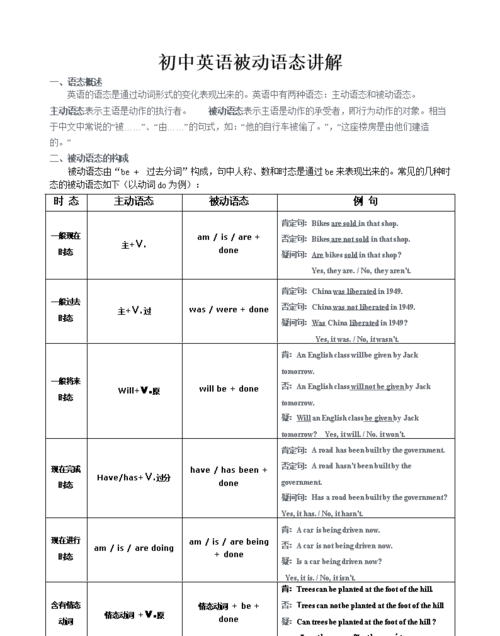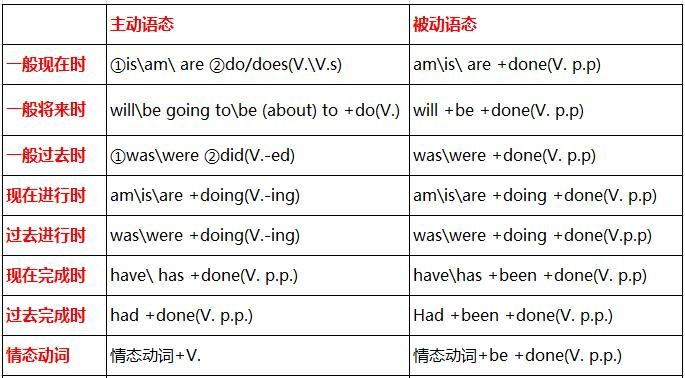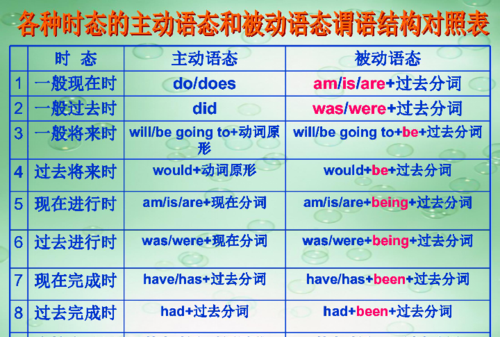本文目录
英语被动语态讲解视频
被动语态的结构为“助动词be+及物动词的过去分词(p.p)”。被动语态的不同时态是通过be的时态变化来表示的,其人称和数方面应与主语保持一致。
扩展资料
其具体变化为:

一般现在时:am/is/are+p.p.
一般过去时:was/were+p.p.
一般将来时:shall /will be +p.p.
现在完成时:have /has been +p.p.
现在进行时:am/is/are+being+p.p.
过去将来时:should /would be +p.p.
含情态动词的被动结构:情态动词+be+p.p.例如:
① Chinese ______ by the largest number of people.(选D。考查一般现在时的被动语态)
A.speak B.is speaking C.speaks D.is spoken
② The boy ______ to get supper ready after school.(选C。考查一般过去时的被动语态)
A.were told B.is telling C.was told D.tells
③ A lot of new roads ______ built in the west of China.(选B。考查含情态动词的被动语态)
A.must B.must be C.has D.have
B.明确用法
被动语态常用于以下两种情况:
1.不知道谁是动作的执行者,或者没有必要指出谁是动作的执行者;
2.强调动作的承受者。例如:
这棵树是那个男孩弄断的。
The tree ______ ______ by that boy. (填was broken)
C.熟练转换
1.将主动语态变被动语态的基本方法为:
①将主动语态的宾语作被动语态的主语;
②谓语动词变为“be+及物动词的过去分词”,并通过be的变化来表达出不同的时态;
③主动语态的主语变为介词by的宾语,组成介词短语放在被动结构中的谓语动词之后。(有时by短语可以省略)。
2.被动语态的一般疑问句是将一个助动词置于主语之前;否定句是在第一个助动词后加not;特殊疑问句的.语序为:疑问词+一般疑问句。例如:
① You must throw the broken pottery away at once.
The broken pottery ______ ______ ______ ______ at once.(同义句) (填must be thrown away)
② Where did they grow vegetables?(改为被动语态)
Where ______ vegetables ______ ?(填were;grown)
D.注意特例
将主动语态变被动语态应注意几个特殊情况:
1.含双宾语的主动结构变为被动结构时,有两种方法:
①将间接宾语变为主语,直接宾语保持不变;
②将直接宾语变为主语,间接宾语用介词to或for引导。例如:
① He told us a story.(变被动语态)
→We were told a story(by him).或:A story was told to us by him.
② Her mother gave her a new pen.(变被动语态)(填was given to)
A new pen ______ ______ ______ her by her mother.
2.短语动词的被动语态:在变为被动语态时,要将短语动词视为一个整体,其后的介词或副词不能省去。例如:
① This dictionary mustn't ______ from the library.[D]
A.take away B.taken awayC.are taken away D.be taken away
② She will take good care of the children.(变被动语态)(填be taken good care of)
The children will ______ ______ ______ ______ ______ (by her).
3.含有复合宾语的主动结构变被动结构时,通常将宾语变为被动句的主语,而宾语补足语就成为主语补足语。注意:省略to的不定式作宾补时,不定式符号to必须补上。例如:
Someone saw him swim in Qianling Lake yesterday.(变被动语态)
He ______ ______ ______ swim in Qianling Lake yesterday.
(填was seen to)
4.不定式的被动结构:动词不定式的被动语态为“to be +过去分词”。例如:
The radio says a wild animal zoo is to ______ in our city.
A.be building B.build C.be built D.built [C]
5.以疑问代词开头的疑问句转换成被动句时要注意词序:应将主动句中的疑问代词改为介词by的宾语,但仍然放在句子开头。例如:
Who has broken the cup?(改为被动语态)
→By whom has the cup been broken?
E.注意区别
被动语态和过去分词作表语的区别:
1)含义不同:被动语态强调动作,重点说明动作由谁完成、怎样完成;而过去分词作表语通常用来描写情景,叙述人或事物的特征及所处的状态。试比较:
The window is broken.窗子破了。(系表结构)
The window is broken by him.窗子被他打破了。(被动语态)
2)用法不同:过去分词作表语时可以被 so,very,too等程度副词修饰,而被动语态则不能用so,very,too修饰,而需用much,very much,so much,too much修饰。试比较:
He was very interested in science.他对科学有极大兴趣。(系表结构)
I was so much surprised at the scene that I didn't know what to do.我被那种场面搞得大吃一惊,不知所措。(被动语态)
F.牢记(相关)句型
初中教材中与被动语态相关的句型有:
1.be covered with被……覆盖
2.be made of由……制作(发生物理变化) be made from由……制作(发生化学变化)
be made in由(某地)制造 be made by被(某人)制造
3.be used for被用来……
be used as被当作(作为)……来使用 be used to do sth.被用来做某事
4.It is said that...据说…… It is hoped that...希望……
It is well known that...众所周知……例如:
①—Your coat looks nice.Is it ______ cotton?[B]
—Yes.It's Shanghai.
A.made of;made by B.made of;made in
C.made for;made by D.made for;made in
② This machine is used ______ the room wet.[A]
A.for keeping B.as keeping C.keep D.to keeping
③ 据说在南京长江上又在建一座桥。
______ ______ ______ that ______ ______ is being ______ over the Changjiang River in Nanjing.
(填It is said;another bridge;built)
初三英语被动语态句型转换
被动语态4
步曲
第1步:被动语态结构
被动语态的时态通过助动词be的变化来表示。经常考查的被动语态结构有:
一般现在时:am
/
is
/
are
+
及物动词的-ed形式
一般过去时:was
/
were
+
及物动词的-ed形式
一般将来时:will
/
shall
+
be
+
及物动词的-ed形式
现在完成时:have
/
has
been
+
及物动词的-ed形式
含情态动词的被动句:情态动词(can
/
should
/
must等)+
be
+
及物动词的-ed形式
第2步:主动句变被动句
☆主动句的宾语变为被动句的主语。当宾语含双宾语时,一般把代表人的宾语(即间接宾语)变为被动句的主语,而把直接宾语留作被动句的宾语。如果把主动句的直接宾语变为被动句的主语,则间接宾语前须加上介词(一般是for或to)。常接to的动词有:give,
tell,
lend,
show,
pass,
hand等;常接for的动词有make,
buy等。
☆主动句的谓语动词变为被动形式,要注意助动词be的时态与主动句的时态保持一致,数与被动句的主语保持一致。
☆主动句的主语变为被动语态中by的宾语(如为代词,主格要变为宾格)。
第3步:被动语态特例展示
特例1
主动句中的谓语是“一感觉(feel)”、“两听(hear,
listen
to)”、“三使(make,
let,
have)”、“四看(see,
watch,
look,
notice)”时,其后作宾语补足语的动词不定式不用to,但变为被动句时,动词不定式符号to要补上。
如:Someone
noticed
Mr
Yu
leave
the
office
at
about
9
am.
→Mr
Yu
was
noticed
to
leave
the
office
at
about
9
am.
特例2
短语动词是一个不可分割的整体,在变为被动句时,不可丢掉构成短语动词的介词或副词,也不能将其拆开。
如:The
workers
put
up
a
tall
teaching
building
in
our
school
last
year.
→A
tall
teaching
building
was
put
up
in
our
school
last
year
第4步:考点预测训练
将下列句子改为被动句。
1.
The
professor
will
give
the
students
an
English
speech
tomorrow.
An
English
speech
to
the
students
by
the
professor
tomorrow.
2.
They
have
painted
their
new
house
blue.
Their
new
house
blue
by
them.
3.
Mom
bought
me
an
MP4
player
last
weekend.
I
an
MP4
player
by
Mom
last
weekend.
An
MP4
player
by
Mom
last
weekend.
4.
The
joke
Lisa
told
made
all
of
us
laugh.
All
of
us
by
the
joke
Lisa
told.
5.
You
should
take
good
care
of
these
books.
These
books
.
参考答案:
1.
will
be
given
2.
has
been
painted
3.
was
bought;
was
bought
for
me
4.
were
made
to
laugh
5.
should
be
taken
good
care
of

被动语态的标志词是什么
应该是通过结构吧
被动语态一般是 be + done
就是be + 动词的过去分词
先看句子里有没有这样的结构,要是有,你先翻译一下,看符不符合语境,要是符合就是了呗

英语的被动语态有哪些
被动语态的基础是be done形式
其次是根据时态的不同而进行的词性变化。
一般现在时:am/is/are done
现在进行时:am/is/are being done
现在完成时:has/have been done
一般过去时:was/were done
过去进行时:was/were being done
过去完成时:had been done
一般将来时:will/shall be done
将来进行时:will be being done
如有不懂欢迎追问。

以上就是关于英文被动语态符号,英语被动语态讲解视频的全部内容,以及英文被动语态符号 的相关内容,希望能够帮到您。

